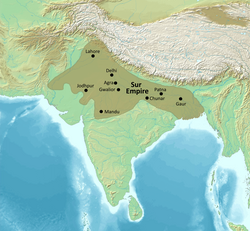
Rana Sangram Singh I, popularly known as Rana Sanga was the Maharana of Mewar from 1508 to 1528 CE. Belonging to the Sisodia Rajput dynasty, through his capable leadership, he transformed the Kingdom of Mewar into the most powerful state in northern India in the early 16th century. He controlled parts of present-day Rajasthan, Gujarat and Madhya Pradesh with his capital at Chittor. His reign was admired by several of his contemporaries, including the first Mughal Emperor Babur, who described him as the "greatest Indian ruler" of that time. The Mughal historian Abd al-Qadir Badayuni called Sanga the bravest of all Rajputs..

Sher Shah Suri, often referred to as Sultan Adil, was the founder of the Sur Empire in India. He was the regent and later sole ruler of Bihar from 1529—1540 until he defeated the Mughal Empire in 1540, founding the Sur Empire, and establishing his rule in Delhi, crowning himself as Emperor. After his accidental death in 1545 CE, his son Islam Shah became his successor. The influence of his innovations and reforms extended far beyond his brief reign. In his reign, he remained undefeated in battle, being renowned as one of the most skillful Afghan generals ever produced.
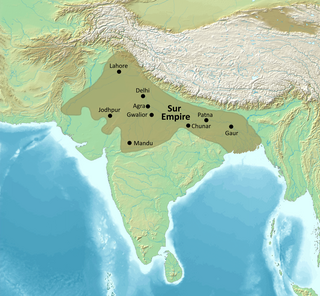
The Sur Empire was an empire ruled by the Afghan-origin Sur dynasty in northern India for nearly 16 or 18 years, between 1538/1540 and 1556, with Sasaram serving as its capital. It was founded by Sher Shah Suri.
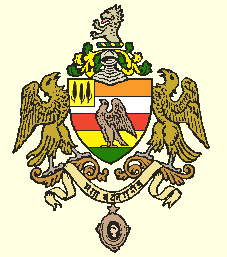
The Rathore or Rathor is an Indian Rajput dynasty belonging to the clan that has historically ruled over parts of Rajasthan, Gujarat and Madhya Pradesh.

Ajit Singh Rathore was the ruler of Marwar region in the present-day Rajasthan and the son of Jaswant Singh Rathore.
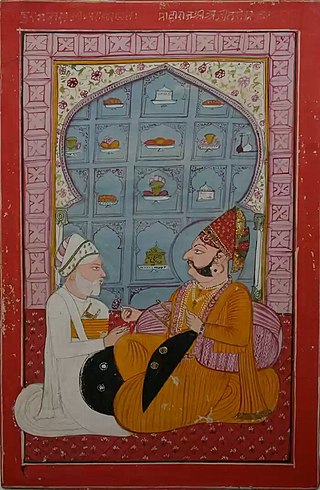
Durgadas Rathore was the Rathore Rajput General of the Kingdom of Marwar. He is credited with having preserved the rule of the Rathore dynasty over Marwar, India, following the death of Maharaja Jaswant Singh in the 17th century. In doing so he had to defy Aurangzeb, a Mughal emperor. He commanded the Rathore forces during the Rajput War (1679–1707) and played a major role in the Rajput Rebellion (1708–1710) and supported the Maratha ruler Sambhaji in the Siege of Janjira aganist the Siddis of Janjira. He was elected as the leader of the revolt along with Raja Jai Singh II of Jaipur. He won a number of victories against the Mughals and forced many Mughal officers to pay tribute to him in the form of chauth.

Rao Maldeo Rathore was a king of the Rathore dynasty, who ruled the kingdom of Marwar in present day state of Rajasthan. Maldeo ascended the throne in 1531 CE, inheriting a small ancestral principality of Rathore's but after a long period of military actions against his neighbours, Maldeo swept significant territories which included parts of present day Rajasthan, Haryana, Uttar Pradesh, Gujarat and Sindh. He refused to ally with either the Sur Empire or the Mughal Empire.

Raja Jaswant Singh I was the Rathore Rajput ruler of the Kingdom of Marwar in the western part of Rajputana modern day Rajasthan .He was a distinguished man of letters and author of noted literary works like "Siddhant-Bodh", "Anand Vilas" and "Bhasha-Bhushan".

Udai Singh II was the Maharana of Mewar and the founder of the city of Udaipur in the present-day Rajasthan state of India. He was the 12th ruler of the Kingdom of Mewar. He was the fourth son of Rana Sanga and Rani Karnavati, a princess of Bundi.

The Kingdom of Mewar, sometimes known as Udaipur State, was an independent kingdom in Rajputana region of India, ruled by the Sisodia dynasty. It originated in the form of the Guhila Kingdom in Mewar. In the 10th century, it transformed into an independent state under Rawal Bharttripatta II.

Kingdom of Marwar, also known as the Jodhpur State under the British, was a kingdom in the Marwar region from 1243 to 1818 and a princely state under British rule from 1818 to 1947. It was established in Pali by Rao Siha, possibly a migrant Gahadavala noble, in 1243. His successors continued to struggle against regional powers for domination and 9 out of 15 rulers till 1438 died in combat. In 1395, its capital was changed to Mandore by Rao Chunda of Mandore and to Jodhpur in 1459 by Rao Jodha.
The Mughal–Rajput wars were a series of battles between the Rajput Confederacy and the Mughal Empire. The conflicts originated with the invasion of northwestern India by the Mughal ruler Babur, to which the head of the Rajput confederacy, Rana Sanga, offered staunch resistance.

Manavati Bai, also spelled Manvati Bai,, better known by her title, Jagat Gosain, was the second wife and the empress consort of the fourth Mughal emperor Jahangir and the mother of his successor, Shah Jahan.
Events from the year 1544 in India.

Rao Chandrasen (1562-1581) was a Rathore Rajput ruler of the Kingdom of Marwar.He was a younger son of Rao Maldev Rathore and younger brother of Udai Singh of Marwar.Rao Chandrasen followed his father's policy and stayed hostile to the ruling foreign powers in north India. He is remembered for resisting the territorial expansion of the Mughal Empire in Marwar.

Bala is a village and a Gram Panchayat in the Ahore Tehsil of Jalore district of Rajasthan in northwest India.
Rao Chunda Rathore was the 12th ruler of Marwar. His reign saw the consolidation of Rathore rule in Marwar, through his diplomatic and military prowess.
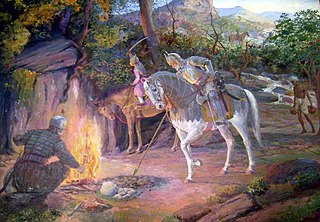
Described variously as the Rajput war, Rathore war of independence and Rathore rebellion, the conflict between Rajputs of Marwar and the Mughals started after the death of Jaswant Singh of Marwar, due to Aurangzeb's attempt to interfere in the succession of Marwar. The resistance to Mughal interference was started by the Rajput nobles under Durgadas Rathore and erupted into an all-out war between the Mughal empire and Rajputs of Marwar supported by Mewar Rajputs. It lasted for almost thirty years. The rebellion reached a climax after the death of Aurangzeb on 3 March 1707 and the capture of Jodhpur by the Rathores on 12 March 1707.
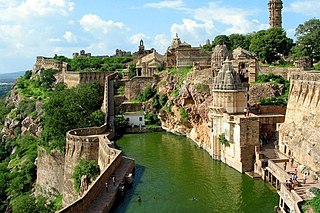
The Siege of Chittorgarh was a pivotal moment in Sher Shah Suri's efforts to expand his influence in the region. By targeting the strategic Chittor Fort, he aimed to solidify his control over Rajputana and establish his authority in the area. The campaign was characterized by intense military tactics and strategic planning, as Sher Shah Suri sought to overcome the formidable defenses of the fort. The siege of Mewar showcased Sher Shah Suri's prowess as a military leader and highlighted his determination to assert his dominance in Rajasthan. The success of this conquest further solidified his reputation as a formidable ruler in the region.
